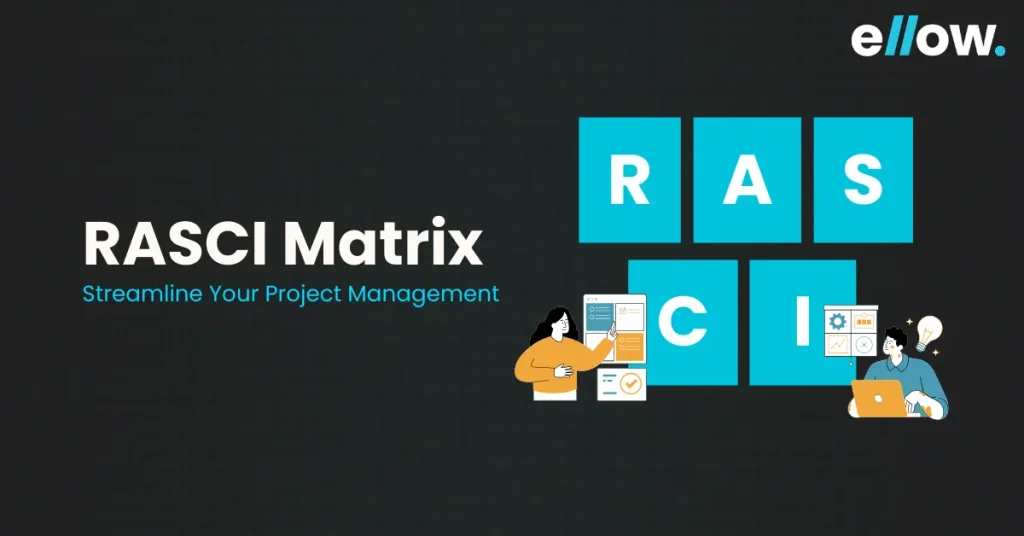In project management, clear roles and responsibilities are crucial for ensuring smooth execution and successful outcomes. The RASCI matrix is an effective tool designed to define and assign roles within a team, ensuring everyone knows their specific duties.
This clarity not only prevents misunderstandings and overlaps but also identifies who is responsible, accountable, supportive, consulted, and informed for each task.
By implementing the RASCI matrix, teams can streamline communication and decision-making processes, reducing delays and improving overall efficiency.
This article explores the RASCI matrix in detail, discussing its components, benefits, and practical applications in project management to help your team achieve optimal performance.
What is the RASCI Matrix?
The RASCI matrix is a framework used in project management to clearly define roles and responsibilities within a team or organization.
RASCI stands for Responsible, Accountable, Support, Consulted, and Informed.
This matrix helps ensure that everyone involved in a project understands their specific duties and involvement, thereby improving communication and collaboration.
The RASCI matrix is designed to delineate and assign roles within a project or team. By mapping out who is responsible for what, the matrix aims to prevent confusion, duplication of effort, and gaps in responsibility.
It enhances clarity, accountability, and efficiency in project execution by clearly outlining each individual’s involvement.
Explanation of Each Component
1. Responsible
The “Responsible” person is tasked with completing a specific activity or deliverable. They are the primary doer of the task and ensure that the work is completed on time and meets the required standards.
2. Accountable
The “Accountable” person holds ultimate ownership of the task or project. They have the authority to make final decisions and are answerable for the outcome. While only one person is accountable for each task, they ensure that responsibilities are appropriately assigned and fulfilled.
3. Support
“Support” refers to those who assist the Responsible person in completing the task. They provide the necessary resources, tools, and assistance to ensure the task is successfully executed. Their role is crucial in facilitating the work and enabling the Responsible person to achieve the task objectives.
4. Consulted
The “Consulted” individuals are those whose opinions or expertise are sought before making decisions. They provide valuable insights and advice, contributing to a well-informed decision-making process. Their involvement is proactive and they play a key role in the planning and evaluation stages.
5. Informed
The “Informed” individuals need to be kept updated on the progress and outcomes of the task or project. They do not participate in the decision-making or task execution but require information to stay aware of developments that may affect their areas of responsibility.
Comparison with the RACI Matrix
The RASCI matrix is an extension of the traditional RACI matrix, which stands for Responsible, Accountable, Consulted, and Informed.
The addition of the “Support” role in the RASCI matrix addresses the need for clear identification of those who assist in task completion but are not directly responsible for it.
This distinction helps in better resource allocation and ensures that supportive roles are explicitly recognized, enhancing the overall efficiency and collaboration within the team.
The inclusion of the “Support” role differentiates RASCI from RACI by:
- Highlighting Support Functions: Explicitly identifying support roles prevents overlooking the contributions of those who assist with resources and aid.
- Improving Resource Management: By clearly defining who provides support, the matrix ensures that necessary resources and assistance are planned and available.
- Enhancing Clarity: The addition of the Support role clarifies the involvement of all team members, reducing ambiguity and improving teamwork.
The RASCI matrix, therefore, offers a more comprehensive approach to role definition in project management, ensuring that every aspect of task execution is covered and all participants are aware of their responsibilities and contributions.
Check this video out: RACI explained it’s simple yet powerful
Benefits of Using the RASCI Matrix
- Improved Clarity and Communication: The RASCI Matrix improves project clarity by clearly defining who is responsible for what tasks, ensuring no overlaps or misunderstandings among team members. This clarity leads to smoother communication channels and reduces the likelihood of errors or delays.
- Enhanced Accountability and Ownership: It enhances accountability by clearly assigning an “Accountable” role to each task or decision. This ensures that there is always someone responsible for the outcome, which motivates timely completion and quality delivery.
- Streamlined Decision-Making Processes: The RASCI Matrix streamlines decision-making by designating an “Accountable” person who has the authority to make decisions. This clarity empowers quicker resolutions and prevents bottlenecks in project progress.
- Better Project Tracking and Management: By clearly defining roles such as “Responsible” and “Consulted,” the RASCI Matrix enables better project tracking and management. Project managers can easily monitor progress, allocate resources, and ensure tasks are completed according to schedule and standards.
How to Create a RASCI Matrix
1. Identify Tasks and Deliverables
Start by listing all the tasks and outcomes your project aims to achieve. Break them down into manageable parts, including any sub-tasks that contribute to the overall goals.
2. Define Roles and Responsibilities
Assign clear roles using the RASCI model:
- Responsible: Identify who will perform each task.
- Accountable: Determine who is ultimately answerable for the task’s success.
- Supporting: Specify who will provide assistance and resources to the responsible person.
- Consulted: List individuals whose expertise is needed during decision-making.
- Informed: Identify who needs to be kept updated on task progress and outcomes.
3. Assign Roles to Each Task
Match each task with the appropriate roles based on skills and responsibilities required for successful completion.
4. Review and Validate with the Team
Gather feedback from team members to ensure roles are clearly defined and understood. This step helps to validate the accuracy of the matrix and ensures everyone is on the same page.
Implementing the RASCI Matrix in Project Management
Tips for Effectively Implementing the RASCI Matrix in a Project
- Define Roles Clearly: Make sure every team member understands their role. This reduces confusion and ensures everyone knows what is expected of them.
- Communicate Openly: Keep lines of communication open. Regular check-ins help address any uncertainties and keep everyone aligned.
- Review Regularly: Periodically review the RASCI matrix to ensure it remains relevant. As projects evolve, roles and responsibilities may need adjustments.
- Get Buy-In from the Team: Involve team members in creating the matrix. This fosters ownership and commitment to their roles.
- Use Tools Wisely: Leverage project management tools to track responsibilities. Digital tools can help visualize and update the matrix easily.
Common Challenges and How to Overcome Them
- Role Confusion: Sometimes roles overlap, leading to confusion. To overcome this, clarify responsibilities in the matrix and discuss any ambiguities with the team.
- Lack of Engagement: Team members might need to fully engage with the matrix. Regular meetings to discuss roles and responsibilities can help maintain interest and commitment.
- Resistance to Change: Implementing the RASCI matrix can face resistance. Educate the team on its benefits and how it can streamline processes.
- Updating Issues: Keeping the matrix updated can be challenging. Assign someone to regularly review and update the matrix to reflect current project needs.
Case Studies or Real-world Examples of Successful Implementation
Implementing the RASCI matrix in project management can streamline processes, clarify roles, and improve overall project efficiency. By addressing common challenges and learning from successful case studies, teams can harness the full potential of this framework.
- Tech Startup: A tech startup implemented the RASCI matrix to manage its product development. By clearly defining roles, they reduced project delays and improved communication among the team. Regular reviews helped them stay on track, and the project was completed ahead of schedule.
- Construction Project: The RASCI matrix helped the team coordinate complex tasks in a large construction project. Assigning clear roles to contractors, architects, and project managers ensured everyone knew their responsibilities. This led to efficient workflow and timely project completion.
- Healthcare Initiative: A healthcare initiative used the RASCI matrix to manage a multi-departmental project. By defining roles for doctors, nurses, and administrative staff, they improved collaboration and reduced misunderstandings. The project achieved its goals faster than anticipated.
Best Practices for Using the RASCI Matrix
- Regularly Update and Review the Matrix
Keep the RASCI matrix up to date. Projects evolve, and roles can change, so it’s essential to review the matrix periodically. This ensures everyone is clear on their responsibilities and the project remains on track. Set a schedule to review the matrix every few months or at key project milestones.
- Ensure Team Buy-In and Understanding
Make sure the entire team understands and agrees with the RASCI matrix. This fosters a sense of ownership and accountability. Discuss the matrix with your team and explain why each role is assigned. This collaborative approach helps in gaining commitment and clarity from all team members.
- Align with Project Goals and Objectives
The RASCI matrix should reflect the project’s goals and objectives. Each role and responsibility should contribute to the overall success of the project. Aligning the matrix with project goals ensures that all activities are purposeful and directed toward achieving the desired outcomes.
- Use Tools and Software
Utilize project management tools and software to manage the RASCI matrix. Tools can help visualize roles and responsibilities, making it easier to track progress and make updates. Software solutions often come with features that facilitate communication and collaboration, which are crucial for effective project management.
- Make it a Collaborative Process
Involve the team in creating and maintaining the RASCI matrix. Collaboration ensures that all perspectives are considered and that the matrix accurately reflects the team’s structure and capabilities. This approach also helps in identifying potential gaps and overlaps in responsibilities early on.
Conclusion
The RASCI matrix is an essential tool for project management. It offers a clear method to define and communicate roles and responsibilities. By assigning specific ownership for tasks, it ensures clarity and accountability within the team.
This framework helps prevent misunderstandings and overlaps, making sure that every stakeholder is involved appropriately. Using the RASCI matrix improves project efficiency, streamlines decision-making, and supports innovation.
Ultimately, it boosts the chances of achieving project success.
FAQs
- What does RASCI stand for?
RASCI stands for Responsible, Accountable, Support, Consulted, and Informed. These roles help define clear responsibilities within a project team.
- How does the RASCI matrix improve project management?
The RASCI matrix improves project management by providing clarity on roles and responsibilities, reducing confusion, preventing duplication of efforts, and ensuring all stakeholders are appropriately involved.
- Who should be involved in creating a RASCI matrix?
Key stakeholders, including project managers, team members, and relevant department heads, should be involved in creating a RASCI matrix to ensure comprehensive and accurate role definitions.
- Can the RASCI matrix be used for any type of project?
Yes, the RASCI matrix is versatile and can be used for various types of projects, regardless of size or industry, to enhance clarity and accountability.
- What is the difference between ‘Responsible’ and ‘Accountable’ in the RASCI matrix?
‘Responsible’ refers to those who perform the task, while ‘Accountable’ designates the person who ensures the task is completed and has the final decision-making authority.









